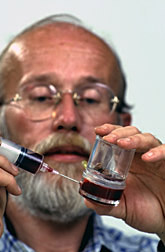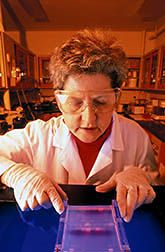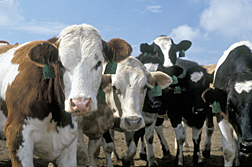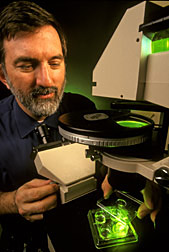|
|
Animal Research and Care Go Hand in Hand
Whenever Charlie Miller could get two nickels together at the same time, he bought one of two things: cows or land. Throughout the Great Depression, Miller painstakingly worked at building a beef herd—and a place to graze it.
Nickels were hard to come by, especially in rural Arkansas. But the animals and the acres added up, and at his death in 1956, Miller left behind a respectable cattle operation of mostly white-faced Herefords.
Within two decades, that land lay idle and the cows were gone—wiped out by an invisible enemy, a bacterial disease called brucellosis.
Even in the 1930's, Miller would have known of brucellosis; it's plagued American cattle herds since the 1840's and still costs U.S. cattle producers an estimated $30 million annually.
But solutions to brucellosis and other animal health problems are now being found in technology that Charlie Miller could never have imagined. And even if brucellosis vaccines had been offered to Miller, he probably would have shied away from using them for the same reason many modern cattle producers hesitate.
It's because the most common vaccine, Strain 19, uses a live strain of the brucellosis bacterium, Brucella abortus. That can actually backfire and thwart cattle sales, since tests cannot distinguish between infected animals and vaccinated ones.
But at the Agricultural Research Service's National Animal Disease Center at Ames, Iowa, researchers have found a way to genetically modify B. abortus Strain 19 to delete a specific protein immunogen, so that any animal whose blood contains that telltale protein will be known to have been naturally infected rather than vaccinated.
At the same time, a technique called polymerase chain reaction (PCR) is probing the bacterium's DNA to cut the time needed for diagnostic tests identifying B. abortus from 2 weeks to a single day.
These advances are typical of the working partnership between techniques such as molecular biology, cell culture, and molecular genetics and traditional live-animal experiments, to speed the search for answers to animal health problems.
"In animal research, we emphasize the 'three R's,'" notes Helene N. Guttman, National Animal Care Coordinator for the ARS National Program Staff headquartered at Beltsville, Maryland.
"First, we want to refine procedures to minimize animal pain and distress. We want to reduce the number of animals required for the experiments needed to reach a project's goal and be statistically meaningful. And finally, whenever possible, we want to replace animals either with those lower in the evolutionary scale or with proven preclinical procedures that do not require the use of a live animal.
"But it wouldn't be good science or ethical science," says Guttman, "to release a vaccine without first testing it on the species that will use it. In clinical experiments to test the safety and effectiveness of a treatment, diagnosis, or vaccine, there can be no substitute for the user animals."
Among the most valued preclinical testing procedures is the use of cellular model systems—cell cultures—which allow researchers to learn how a disease agent such as a virus, bacterium, or parasite, or a potential vaccine, might affect a living cell before it is tested in a whole animal.
"Cell culture is one of the more important developments in disease research to allow us to use alternatives to live animals," says Thomas E. Walton, ARS national program leader for animal health.
"The basic premise is that every vessel of cell culture is equivalent to a live animal. If you're determining virus concentration in order to evaluate a vaccine, you make various dilutions of the virus. You have to inoculate perhaps a dozen mice per dilution, times so many dilutions. With cell culture, 144 tubes of cell culture can replace 144 mice.
|
|
"Every single farm animal disease lab in ARS uses cell cultures, and they're also used in our fish labs," Walton points out. "This allows us to significantly reduce the number of live animals we need, and it's much more economical.
"A tube of cell culture may cost 25 cents in an incubator that costs $5,000, but you'll spend maybe hundreds of dollars for a cow and hundreds of thousand of dollars for the facility to house that cow. In addition, it takes months or years to complete an experiment with live animals, compared with weeks for a cell culture experiment."
Cell culture has been the cornerstone of research by immunogeneticist Joan K. Lunney, who is at the ARS Parasite Immunobiology Laboratory in Beltsville, Maryland. Lunney is investigating why some pigs can survive an infection that lays waste to others in the herd.
"I specialize in the major histocompatibility complex (MHC) antigens," says Lunney. "These antigens cause the animal's body to respond to a particular pathogen or infectious agent and produce a protective or destructive immune response."
These different immune responses are regulated by different kinds of cytokines, the soluble proteins produced by white blood cells that can be potent weapons against infection.
"We can culture cells for which we already know the MHC antigens present," Lunney explains. "Then we look at the cytokines produced in those cells in response to culturing with different pathogens or proteins isolated from the pathogens.
"For example, if I culture these cells with a certain pathogen, do they produce cytokine 1, 2, or 3? If I give the pathogen to two animals and one gets really sick while the other heals, it is possible that their cells' production of cytokines is the difference."
An important step along the road to finding disease-resistant pigs is identifying the cytokines needed to overcome a specific disease. Lunney and colleagues are working to produce monoclonal antibodies that can help pinpoint the specific cytokines produced in cell culture.
Additionally, Lunney's team is moving in even closer to study messenger RNA, which is a chemical signal that the gene that will eventually produce the crucial cytokine is "turned on" and working. To detect this chemical, the team will use PCR, the same sensitive technology used at Ames to unmask B. abortus. "But to do any of this, we have to have cell culture," Lunney notes.
Cell culturing was also crucial to one of the great success stories of poultry health: development of vaccines against Marek's disease that eventually saved U.S. poultry producers $200 million a year.
"Gaining the ability to grow the virus in cell culture allowed the virus to be identified," recalls veterinarian Richard L. Witter. He is at the ARS Avian Disease and Oncology Laboratory at East Lansing, Michigan, where the most commonly used Marek's disease vaccine was developed in 1971. "Probably within 12 months after the virus was identified, the first vaccines were developed," Witter says.
"Growing viruses in chicken embryos or cell culture allows the virus to mutate. Then we can look for a mutant that lacks the pathogenic or disease-causing element but will still stimulate the bird's immune response to produce resistance against the disease. I can't imagine coming up with the same research information we've had on Marek's disease without cell culture techniques."
But for all the benefits of cell culture, it can never replace the more complex live animal in demonstrating the overall impact of a virus, vaccine, or toxin, Walton emphasizes.
"By growing the virus in cultured cells, you can tell when cells begin to get sick," he says. "This in turn can give you an idea of how to scale-up your experiment to determine the effects on the live animal.
"But when, for example, you need to look for possible side effects of a new treatment, you have to use a live animal. It may be that normal body metabolism might disrupt your vaccine; hormones can affect how an individual responds to a vaccine. So while you can do a lot with artificial stems such as cell cultures, certain things have to be done in the animal."
Prion Gene Flags Susceptibility
Genetics is the name of the game at the Animal Disease Research Unit in Pullman, Washington, where microbiologist Katherine I. O'Rourke is working on fine-tuning research on scrapie, a neurologic disease of sheep. One problem with studying scrapie is that signs of infections might not appear until 3 to 4 years after exposure to the disease agent, and only about half of those sheep exposed will actually get the disease.
"If you're doing a field study, this typically means you have to double the number of animals used in the study to get a statistically significant sample of infected animals," O'Rourke points out.
Scientists with the University of California at San Francisco reported early 1994 that sheep with a particular form of gene they called a prion gene seemed to be more susceptible to scrapie infection. O'Rourke, comparing prion gene sequences from scrapie-infected sheep with flock-mates or relatives that didn't get the disease, noted the same phenomenon in studies at Pullman.
"We saw a particular form of prion gene in Suffolk sheep that seemed to predispose them to get scrapie if exposed to it," says O'Rourke. "We've identified a susceptible gene, at least for Suffolk sheep; other prion gene sequences could be involved in other breeds.
"This doesn't mean that an animal that doesn't have this prion gene sequence is resistant. It could be a carrier and go off and simply spread the disease agent. But having the information we now have will make it easier for us to do the field studies we need to do with fewer sheep."
Also at Pullman, microbiologist Willard L. Goff has found an innovative way to cut down on the animals needed to study bovine babesiosis, a costly blood disease of cattle.
"With any hemoparasitic disease such as babesiosis, the real immunologic action is taking place in the animal's spleen," explains Goff. "It's not practical to sacrifice large numbers of infected calves to see what's happening in their spleens. And even if you did that, the calves wouldn't all be genetically identical, so the results might not be consistent. It's much better to get sequential information from the same spleen."
To accomplish this, Goff and colleagues modified an existing technique to reposition a calf's spleen in a pouch just under the animal's skin. At crucial times in their studies, the scientists can use a large needle to extract spleen cells through a small incision in the animal's skin. Since the animal is treated with a local anesthetic before extraction of the cells, it experiences no pain and the spleen continues to work as it always has, Goff says.
"Now we're able to do basic studies to see what cell populations in the spleen are involved in the early successful immune response to a babesiosis infection. We hope to design a vaccine based on what's going on in there, by mimicking the stimulant that results in a successful immune response. And we're doing this with fewer than a dozen animals versus perhaps 100 over the next few years."
Computer modeling is another promising avenue for finding answers in animal research. For example, ARS rangeland scientist Jon D. Hanson and colleagues have been able to simulate on computer the results of climatic shifts on the Great Plains as carbon dioxide levels rise over the next 50 years, to see how these changes will affect beef cattle production.
 Special feeding chambers like this one used by entomologist Michael Coan take the place of live animals in research on pests such as Rocky Mountain wood ticks. (K5526-3) |
The group, located at the ARS Great Plains Systems Research Unit in Fort Collins, Colorado, incorporated information from one computer model on forage growth into another model that looks at cow/calf life-cycle response to changes in forage quality and quantity, as well as to changes in weather conditions.
Among their predictions: In Texas, though grass production may rise about 18 percent, cattle would eat 22 percent less, mainly because of lower digestibility of the forage. The end result would be cows weighing 12 percent less and calves weighing 5 percent less at weaning.
But years of further research must be done before enough real-life data is available to begin creating such computer models, says Tom Walton.
"There's no way, for example, that you can put information about a substance such as a drug into a computer and predict something like limb deformities from certain chemicals," Walton warns.
"The computer helps analyze data and can extend information from 100 animals to make predictions on a population. But if you don't already have all the available metabolic, physiologic, and hormonal information from studies with live animals, a computer model is not going to generate accurate information about a potential drug or vaccine from scratch."
Another important new tool, Walton notes, will be the cattle and swine genome maps under development at ARS' Roman L. Hruska U.S. Meat Animal Research Center at Clay Center, Nebraska. These should be invaluable in speeding the search for answers about animals.
"Soon we can begin to look at these genetic maps, put together physical characteristics with certain genes, and look for certain gene sequences to predict genetic traits and genetic resistance to disease, without having to do the breeding experiments," Walton says.
"The Clay Center work has shown us the technology is doable. Katherine O'Rourke's work is the first real application of that, and we'll probably find other diseases with the same type of genetic relationship.
If we can someday take a blood sample or a piece of skin and—based on what it tells us about an animal's genetics—make a prediction about how that animal will respond in an experiment, we will have come a long way toward reducing the number of live animals we have to use in studies." — By Sandy Miller Hays, ARS.
Joan K. Lunney is at the USDA-ARS Animal Parasitic Diseases Laboratory, Building 1040, Room 103, 10300 Baltimore Ave., Beltsville, MD 20705; phone (301) 504-9368, fax (301) 504-5306.
USDA-ARS Avian Disease and Oncology Research Unit, 3606 East Mt. Hope Road, East Lansing, MI 48823; phone (517) 337-6828, fax (517) 337-6776.
Katherine I. O'Rourke and Willard L. Goff are with the USDA-ARS Animal Disease Research Unit, 337 Bustad Hall, Washington State University, Pullman, WA 99164-7030; phone (509) 335-6020, fax (509) 335-8328.
USDA-ARS Great Plains Systems Research Unit, 2150 Centre Avenue, Building D, Suite 200, Fort Collins, CO 80522; phone (970) 492-7300.
"Animal Research and Care Go Hand in Hand" was published in the February 1995 issue of Agricultural Research magazine.









